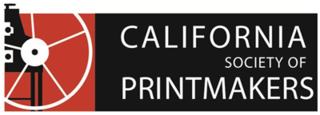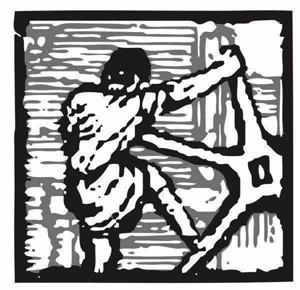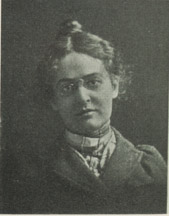
Lindsborg is a city in McPherson County, Kansas, United States. As of the 2020 census, the population of the city was 3,776. Lindsborg is known for its large Swedish, other Nordic and Scandinavian Americans (Nordic-Scandinavian), and German heritages, It is home of the biennial Svensk Hyllningsfest.

Aquatint is an intaglio printmaking technique, a variant of etching that produces areas of tone rather than lines. For this reason it has mostly been used in conjunction with etching, to give both lines and shaded tone. It has also been used historically to print in colour, both by printing with multiple plates in different colours, and by making monochrome prints that were then hand-coloured with watercolour.

Bethany College is a private four-year Christian liberal arts college in Lindsborg, Kansas, United States, associated with the Evangelical Lutheran Church of America. It was founded in 1881, making it one of the oldest colleges in Kansas.

Intaglio is the family of printing and printmaking techniques in which the image is incised into a surface and the incised line or sunken area holds the ink. It is the direct opposite of a relief print where the parts of the matrix that make the image stand above the main surface.

The etching revival was the re-emergence and invigoration of etching as an original form of printmaking during the period approximately from 1850 to 1930. The main centres were France, Britain and the United States, but other countries, such as the Netherlands, also participated. A strong collector's market developed, with the most sought-after artists achieving very high prices. This came to an abrupt end after the 1929 Wall Street crash wrecked what had become a very strong market among collectors, at a time when the typical style of the movement, still based on 19th-century developments, was becoming outdated.

Sven Birger Sandzén, known more commonly as Birger Sandzén, was an American painter best known for his landscapes. He produced most of his work while working as an art professor at Bethany College, Lindsborg, Kansas.
An old master print is a work of art produced by a printing process within the Western tradition. The term remains current in the art trade, and there is no easy alternative in English to distinguish the works of "fine art" produced in printmaking from the vast range of decorative, utilitarian and popular prints that grew rapidly alongside the artistic print from the 15th century onwards. Fifteenth-century prints are sufficiently rare that they are classed as old master prints even if they are of crude or merely workmanlike artistic quality. A date of about 1830 is usually taken as marking the end of the period whose prints are covered by this term.

The Royal Society of Painter-Printmakers (RE), known until 1991 as the Royal Society of Painter-Etchers and Engravers, is a leading art institution based in London, England. The Royal Society of Painter-Etchers, as it was originally styled, was a society of etchers established in London in 1880 and given a Royal Charter in 1888. Engraving was included within the scope of the Society from 1897, wood-engraving from 1920, coloured original prints from 1957, lithography from 1987 and all forms of creative forward-thinking original printmaking from 1990.
Walter Joseph Phillips was an English-born Canadian painter and printmaker. He is credited with popularizing the colour woodcut in the style of the Japanese, in Canada.

The California Society of Printmakers (CSP) is the oldest continuously operating association of printmakers and friends of printmakers in the United States. CSP is a non-profit arts organization with an international membership of print artists and supporters of the art of fine printmaking. CSP promotes professional development and opportunity for printmakers, and educates artists and the public about printmaking. New members are admitted by portfolio review. Friends, Institutional and Business members are admitted by fee. CSP is based in the San Francisco Bay Area, California.
Norma Bassett Hall (1889–1957) was an American printmaker. She was a woodblock printmaker and often depicted landscapes and outdoor scenes.
Bertha Boynton Lum was an American artist known for helping popularize the Japanese and Chinese woodblock print outside of Asia.

Tom Huck, also spelled Hück,, is an American printmaker best known for his large-scale satirical woodcuts. He lives and works in St. Louis, Missouri, where he runs his own press, Evil Prints. He is a regular contributor to BLAB! of Fantagraphics Books. His work is influenced by Albrecht Dürer, José Guadalupe Posada, R. Crumb, and Honoré Daumier. Huck's illustrations have appeared in publications such as The Village Voice, The Riverfront Times, and the Minneapolis City Pages.

The Society of American Graphic Artists (SAGA) is a not for profit national fine arts organization serving professional artists in the field of printmaking. SAGA provides its members with exhibition, reviews and networking opportunities in the New York City area and, in addition to various substantial exhibition prizes, many purchase awards allow SAGA members to be included in major U.S. museum collections.

Frances Gearhart was an American printmaker and watercolorist known for her boldly drawn and colored woodcut and linocut prints of American landscapes. Focused especially on California's coasts and mountains, this body of work has been called "a vibrant celebration of the western landscape." She is one of the most important American color block print artists of the early 20th century.
Alice Geneva "Gene" Kloss was an American artist known today primarily for her many prints of the Western landscape and ceremonies of the Pueblo people she drew entirely from memory.
Doris Boulton later Doris Boulton-Maude, (1892–1961) was a British artist, notable as a wood engraver, etcher and for her colour woodcut prınts.

Carl Lotave was a painter of portraits, illustrator, and sculptor. He painted portraits of notable leaders of World War I and is best known for his two portraits of President Abraham Lincoln. Lotave was an art instructor at Bethany College in Kansas.
Cecil Carstenson (1906–1991) was an American sculptor. He was born in Marquette, Kansas, and lived in Kansas City most of his life. He was a sculptor for 50 years, working exclusively in wood for the last 40 years of his life.His work has been displayed in more than 25 museums, colleges and public buildings, including the Nelson-Atkins Museum of Art; the Phoenix Museum; the Museum of Nebraska Art; the Josyln Museum in Omaha, Nebraska; the University of Missouri-Kansas City; St. Benedict's College in Atchison, Kansas; the Birger Sandzen Gallery of Art in Lindsborg, Kansas; the Missouri State Historical Museum; the Kansas City Art Institute; and the Wichita Museum of Art. He exhibited sculptures in the Missouri Pavilion at the 1964 World's Fair in New York.
Augusta Payne Briggs Rathbone was an American painter, etcher and printmaker. She studied at the University of California, Berkeley and in Paris. She depicted people and locations from San Francisco, the Sierra, New York City, the West Coast of Canada, the Canadian Rockies, and France. In 1938, she published a book of aquatints of French Riviera Villages with photographs by Juliet Thompson and text by Virginia Thompson. Her work appeared internationally in group and solo exhibitions, and continues to appear in retrospectives of American printmaking.












